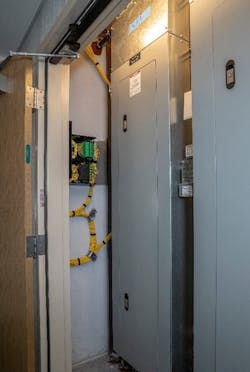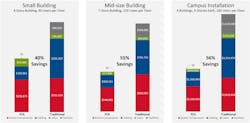The elimination of costly IDFs is one of many capex-reducing elements that users enjoy when they switch to POL. This and many other aspects are highlighted in the recently released cost comparison produced by the Technology Committee of the Association for Passive Optical LAN (APOLAN). The goal of the committee was to highlight the many cost aspects that go into assembling a modern in-building network. The committee is made up of integrators and manufacturers that possess a wide range of expertise across the networking industry. The deep knowledge of the committee was used to build the comparison. Numerous revisions were made to the comparison over a series of debates as it was developed. Contributors to the comparison knew it was important to properly compare the two technologies when evaluating costs.
All aspects of the network integration are considered in the cost comparison: active components, cabling, labor, and facilities. The full details in each category were considered in the installation, from the SFPs in the switches to the access control on the door of the IDF. The components were selected to closely align the services provided in both solutions, such as available bandwidth to the user, redundancy, and features. The “Traditional” network parameters are based on building out 10G uplinks from core to access switches over multimode fiber and gigabit access ports to the end-users using Category 6 cabling. The POL parameters include 10G uplinks to the OLT, Type-B protection to the GPON ONTs, and shared four-port ONTs at the end-user. The comparison results in very similar experiences that could not be differentiated by the end-user. “Users can’t tell the difference.” says Chris Ennis with Nokia and a member of the Technology Committee. “The performance is comparable. The only way they would be able to tell the difference is to look at the cables under the desk.”
Three scenarios are presented in the comparison: a small building, a mid-size building, and a campus installation (Figure 2). The intent was to demonstrate how costs differed across various installation sizes. The group wanted to produce something that would resonate with the typical LAN designer. Each scenario was modeled from what the group is seeing in the real world. The comparison clearly shows that the savings from POL grow with the size of the installation. Anecdotal evidence has shown these types of savings for years, but to have a document produced by a respected organization and reviewed by individuals across the industry is just what enterprise decision-makers need.
At first glance, the port-by-port similarity in cost between traditional and POL networks seems unremarkable. However, when one considers the optical nature of the products, the fact that the POL components are less expense is quite amazing. At a cursory level, one would think that deploying a laser-driven network device at every endpoint would be the more costly solution. LAN users can thank the carriers for these low costs. The near-universal adoption of passive optical network (PON) technologies in the fiber-to-the-home market has driven the product pricing from premium “bleeding-edge” down to commodity. With tens of millions of ONTs shipping to the carriers each year, prices continue to fall while features increase. It’s a win for enterprise networks.
Facilities costs are the hidden gem for many POL installations. “Many IT budget managers don’t think about the costs to install a network beyond the cables and switches” says Blaine Overstreet, senior solutions consultant at AECOM and member of the APOLAN Technology Committee. However, there’s much more to installing a network than just those basic components. Sometimes IT professionals forget that constructing closets, installing HVAC, and securing spaces all have significant associated costs. Not only is there a cost to build out these spaces, such projects might be stealing valuable real estate that could otherwise be used for an office or workspace. In some markets that space can even generate revenue as a larger hotel room or extra retail space. Architects have long wrestled with information and communication technology designers over square footage for this very reason.
The labor portion of the comparison might be the most interesting aspect. It shows the labor associated with a POL installation is more expensive than a traditional network with a flip to cost savings on the larger installs. Part of the reason for this difference is the initial adoption the new technology in the environment. Once the initial head-end system is built though, the incremental costs are lower. This “new technology” is often a reason why some IT departments initially resist POL. The savings are evident, but the prospect of learning something new can be intimidating for network engineers who have done the same thing for 20 years. “Once they realize that it’s the same concepts applied to a new technology, network engineers are often excited about finding new ways to apply their knowledge,” says Overstreet. The central management of POL means that ONTs aren’t managed on a one-by-one basis. Instead, the ONTs report to the OLT to receive all of their programming, essentially acting as an extension of Ethernet ports to the desktop. It’s all managed from a single place.
One aspect that is most surprising for many budget managers is the significant savings associated with POL cabling (Figure 3). Most people associate high costs with the multimode fiber with which they are more familiar in the LAN environment. However, the cost of single-mode fiber is orders-of-magnitude less than that of twisted-pair copper cabling. When compared to single-mode fiber on a per-foot basis, Category 5e comes in at about 2.3X the price and Category 6a at 6X the price. So it’s easy to see how POL can produce significant savings in the cabling alone.
Chief financial officers, IT directors, and the leaders who manage budgets are taking note and increasingly making the decision to go with POL. The global adoption of this technology in the LAN environment continues to increase. Manufacturers have taken note too. The number of POL manufacturers has rapidly increased as more are now looking beyond the broadband access market and expanding into the LAN market. This is a clear indication that the technology has matured and gained sufficient traction. This momentum creates a robust competitive landscape that will ensure better products and features for the market.
As we look at network upgrades many years into the future, adopters of POL will really see the cost benefits come to fruition. The fiber and optical splitters being installed in networks today are the same type that will be installed down the road to bring 10G and 40G service to the desk. In a POL, the only components necessary to make the jump from 2.5G, to 10G, to 40G are the electronics on the ends of the fiber. It helps that the cable manufacturers often provide decades-long warranties on their installed fiber. Imagine that – a network infrastructure that won’t be outdated 10, 15, or 20 years after it is installed.
Matt Miller leads the Networks discipline at AECOM with over 20 years of experience in systems and network engineering. He has been working with passive optical LAN since it was first introduced to the LAN environment in 2006 and has installed hundreds of thousands of POL-based Ethernet ports since that time. Matt holds a Master’s Degree in Information Technology and a Bachelor’s in Business. He serves on the Technology Committee and as chairman of the board for the Association for Passive Optical LAN.
About the Author
Matt Miller
Head, Networks discipline at AECOM
Matt Miller leads the Networks discipline at AECOM with over 20 years of experience in systems and network engineering. He has been working with passive optical LAN since it was first introduced to the LAN environment in 2006 and has installed hundreds of thousands of POL-based Ethernet ports since that time. Matt holds a Master’s Degree in Information Technology and a Bachelor’s in Business. He serves on the Technology Committee and as chairman of the board for the Association for Passive Optical LAN.



